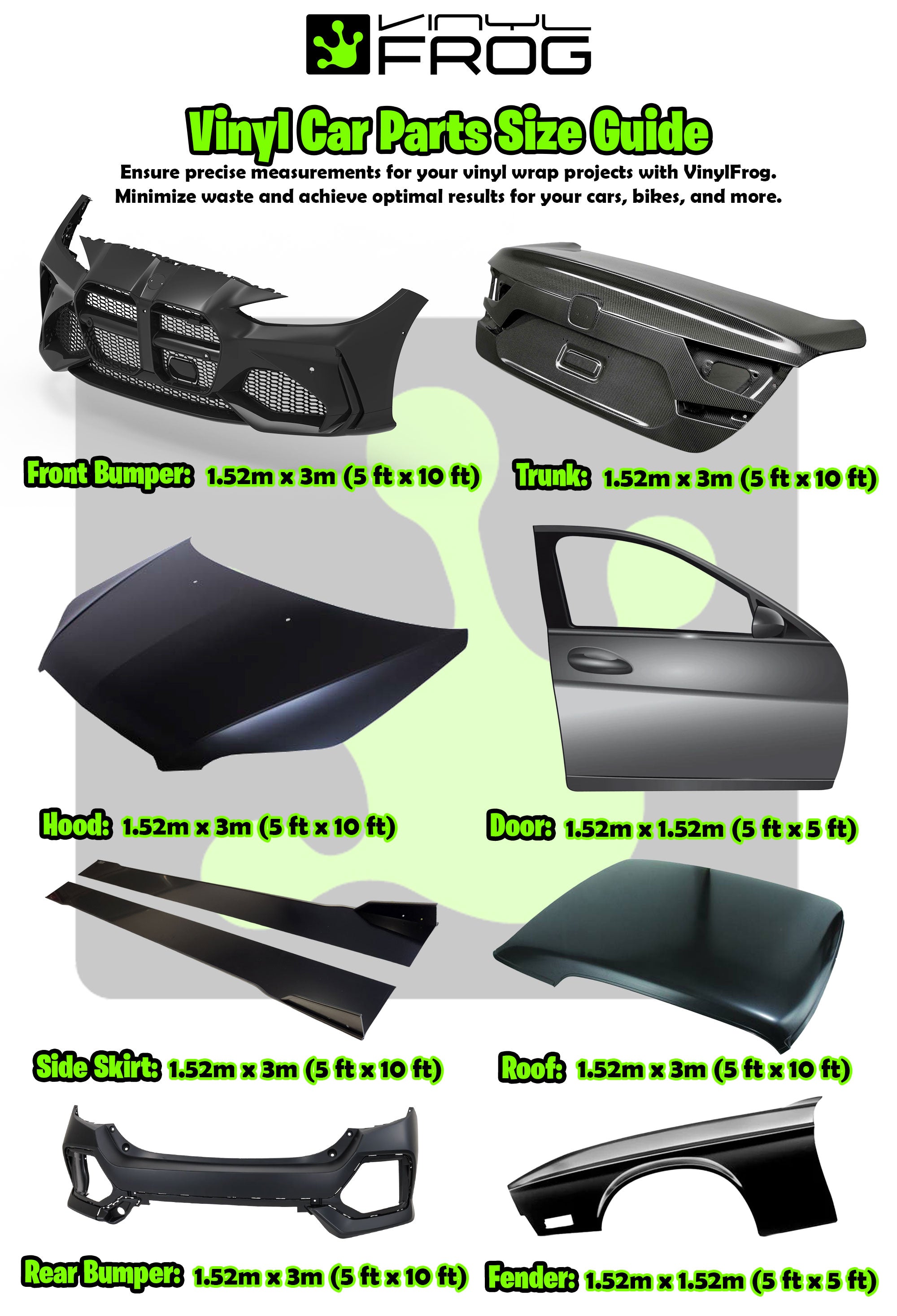Updated By Vinyl Frog On March 28, 2024
How Much Vinyl Needs To Wrap Your Vehicle

Knowing exactly how much vinyl you need to save your time, money, and material. Order too little, and you won’t finish the job. Order too much, and you’ll waste product and budget.
That’s why knowing exactly how much wrap your vehicle needs isn’t just about numbers, it’s about getting the job right the first time. Most vehicles need between 50 and 125 feet of vinyl wrap, depending on their type and size.
Compact cars like the Mini Cooper use around 50–60 ft, while sedans such as the Tesla Model 3 typically require 65-75 ft, and larger SUVs, trucks, or vans can need up to 125 ft for full coverage. On the other hand motorcycles needs just 10–15 ft for a complete wrap.
We break down everything you need to accurately calculate your wrap requirements, from size charts and real-world examples to professional measuring tips.
Quick Formula To Measure How Much Vinyl Needs To Wrap?
If you're trying to figure out how much vinyl you need to wrap a vehicle, here are some quick formulas to get the right amount.
Width x Length x Repeat = Total Yardage
- Width is the length of the side of the vehicle or any other flat surface you are trying to cover.
- Length is the length of the vehicle from front to back (or back to front).
- Repeat is the number of times that length will be repeated on either side of your project area.
(Length x Width x Number of Seams) x 0.5" = Total Square Feet
Example: (12" x 12" x 2) x 0.5" = 30 Square Feet
So if you have an 8" X 8" piece of plastic wrap and want to cover it with a 6" X 6" piece of paper, then simply multiply 8 X 8 X 2 = 96 square inches. 96 square inches divided by 3 equals 32 square feet total amount of material needed for this project.
Factors to Consider When Calculating Vinyl Wrap Requirements
Several factors affect how much vinyl you’ll need beyond just vehicle size. Here’s what professionals consider before starting a wrap project:
- Vehicle Size and Shape: Larger vehicles like SUVs, vans, or trucks need more vinyl than compact cars or motorcycles. Curved or detailed body panels also require extra material for stretching and trimming.
- Wrap Type: A full wrap covers the entire exterior, while a partial wrap focuses on select areas like the hood or roof. Partial wraps can reduce material needs by 30–50%.
- Finish and Thickness: Matte, gloss, metallic, and textured films differ slightly in stretch and thickness. Thicker wraps may need more overlap and precision.
- Skill Level: Always add 10–20% extra vinyl for seams, errors, and adjustments. Beginners should allow a little more to avoid running short.
- Surface Details: Accessories like mirrors, spoilers, and bumpers add surface area. Measure these separately to ensure complete coverage.
Width And Height Of Your Vehicle
The size of your vehicle will determine how much coverage you need. For example, a small car might only need one piece of vinyl, but a truck could need several pieces. The size of the object or area you're covering is also important. If it's a large vehicle, for example, you may need more than one roll of vinyl in order to cover it entirely.
Length And Width Of The Area You Want To Cover
The length and width of your vehicle play the biggest role in determining how much vinyl wrap you’ll need. Larger vehicles such as SUVs, trucks, and vans require more material than smaller cars or motorcycles. To get an accurate estimate, use a measuring tape to record the length and width of major panels, including the hood, roof, doors, fenders, and bumpers. Once you calculate your total surface area, always add 10–20% extra to cover overlaps, complex curves, and small errors during installation. This ensures you have enough material to finish the job cleanly without wasting time or money on reorders.
For instance, a motorcycle might need just 10–15 sq. ft. of vinyl, while sedans like the Tesla Model 3 typically use 55–65 ft. of a 60-inch roll. Larger SUVs, trucks, and commercial vans can need up to 100 ft. or more, depending on their size. If you’re working on a smaller budget, consider a partial wrap, covering high-visibility areas like the roof, hood, or bumpers to refresh your vehicle’s look without committing to a full transformation.

How Much Vinyl You’ll Need to Wrap Different Types of Vehicles
| Vehicle Type | Estimated Vinyl Needed | Recommended Roll Width | Notes |
|---|---|---|---|
| Motorcycle / Scooter | 10–15 ft (3–5 m) | 60 in (1.52 m) | Small panels and curved surfaces; allow extra for tank and fairings. |
| Compact Car / Hatchback | 50–55 ft (15–17 m) | 60 in (1.52 m) | Ideal for vehicles like Mini Cooper or Honda Fit. |
| Sedan / Coupe | 55–65 ft (17–20 m) | 60 in (1.52 m) | Covers four doors, roof, bumpers, and mirrors with minor overlap. |
| SUV / Crossover | 65–75 ft (20–23 m) | 60 in (1.52 m) | More surface area and curves—common for Model Y, RAV4, etc. |
| Pickup Truck | 75–90 ft (23–27 m) | 60 in (1.52 m) | Add extra for tailgate, bed sides, and wheel arches. |
| Van / Commercial Vehicle | 90–125 ft (27–38.1 m) | 60 in (1.52 m) | Larger, flat panels; ideal for fleet and branding wraps. |
| Boat / Watercraft | 20–150+ ft (6–46+ m) | 60 in (often multiple rolls) | Varies hugely by vessel: small tenders & PWC (20–40 ft), runabouts & center consoles (40–100 ft), large yachts need custom estimates. Use marine-grade vinyl & adhesives, and consider professional installation. |
Each vehicle type has unique dimensions and contours, so these figures serve as general professional estimates. For best results, always order 5–10 extra feet to account for edges, patterns, and trimming.


How Long Does It Take to Wrap a Vehicle?
The time it takes to wrap a vehicle depends on its size, design complexity, and installer experience. On average, a full car wrap takes 1 to 3 days, while larger vehicles such as SUVs, trucks, or vans can take 3 to 5 days to complete. If you’re wrapping a boat or other watercraft, installation may stretch to 5–7 days, since marine wraps require more precision and surface preparation.
Professional wrap shops typically spend the first day cleaning and prepping the surface, followed by panel wrapping and detailing on the next. Intricate designs, multi-color wraps, or custom graphics can extend the timeline further. DIY installations usually take longer, especially for beginners, since it’s essential to work slowly to prevent air bubbles and ensure proper adhesion.
Final Words
Knowing how much vinyl your vehicle needs saves you from costly mistakes and wasted material. Most cars require 50–75 feet, while larger SUVs or vans may need up to 125 feet for full coverage. Always add a little extra for curves and trimming to ensure a smooth, professional wrap every time.











